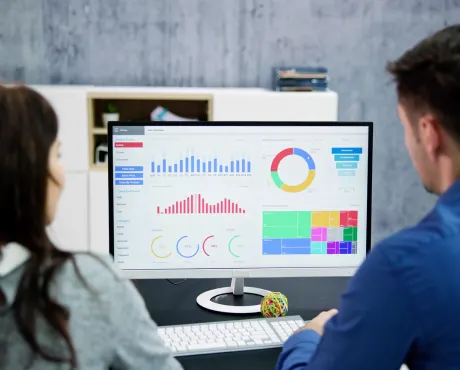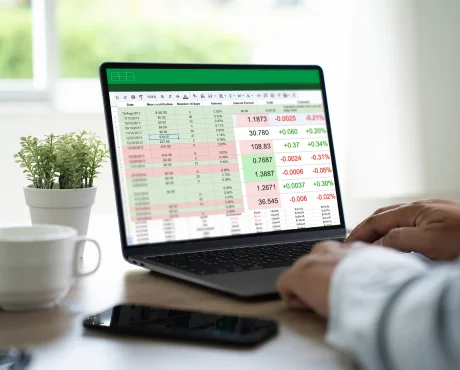Budgeting in manufacturing has never been easy. Between rising material costs, unpredictable supply chains, and ever-changing customer demand, it’s a constant juggling act. And for many companies, budgeting is still a slow, manual process built on spreadsheets and last year’s numbers. That worked, kind of, ten years ago. But today? It’s not enough.
What if you could look ahead with confidence and see what’s coming? That’s where predictive reporting comes in. This approach uses data, patterns, and technology to give you a clearer picture of what might happen next, so you can plan smarter and stay ahead of the curve.
In this article, we’ll look at how predictive reporting is changing the way manufacturers handle budgeting, why it’s such a game-changer, and how to get started.
What Is Predictive Reporting?

Think of predictive reporting as a way to make your budgeting process forward-looking instead of just backward-looking.
Traditional reporting tells you what happened last month, last quarter, or last year. Predictive reporting uses the same data, but with the help of algorithms and tools that spot trends and patterns, to make educated forecasts about what’s likely to happen next.
In a manufacturing setting, predictive reporting pulls in data from across the operation, like:
- Historical production volumes
- Equipment usage and maintenance records
- Labor costs and staffing levels
- Raw material prices
- Utility and energy usage
- Supply chain performance
- Customer orders and seasonal demand
When this data is properly combined and analyzed, it can provide accurate predictions about future costs, potential issues, or areas where you might need to adjust your budget.
Why Traditional Budgeting Is Falling Short
Most manufacturers still create budgets the old-fashioned way: they look at last year’s numbers, make some assumptions, and add a bit of cushion for unknowns. This works fine, until it doesn’t.
Let’s say material costs suddenly spike, or a critical machine goes down and throws off your entire production schedule. Or maybe a key customer increases their order volume unexpectedly. In these situations, static budgets fall apart fast.
Predictive reporting helps you budget proactively, so instead of reacting after a problem hits, you can plan for it ahead of time.
How Predictive Reporting Improves Manufacturing Budgets

1. More Accurate Forecasting
By analyzing trends and real-time data, predictive tools can help you estimate costs more accurately, especially variable ones like materials, energy, or overtime. Instead of guessing how much you’ll spend next quarter, you get data-backed projections that reflect your current operations.
2. Better Planning for Downtime and Maintenance
Sudden equipment breakdowns can quickly derail even the most carefully planned manufacturing budgets. But predictive models can analyze equipment data and flag patterns that usually come before a breakdown. That way, you can schedule maintenance early and set aside the right amount in your budget, avoiding expensive downtime and emergency repairs.
3. Scenario Planning Made Easy
What happens if steel prices rise 10% next month? What if a key supplier is delayed? With predictive reporting, you can run “what-if” scenarios and instantly see the impact on your budget. That makes it easier to prepare for different outcomes and build budgets that can flex when needed.
4. Smarter Spending Across Departments
Predictive insights also help you prioritize where to spend. If one product line is projected to see a spike in demand, it might make sense to invest more in labor or raw materials for that line. If another is slowing down, you can scale back before wasting budget.
5. Less Manual Work, Fewer Errors
Let’s be honest, traditional budgeting is time-consuming. Predictive reporting automates a lot of that work and reduces human error, freeing up your team to focus on strategy instead of spreadsheets.
What It Takes to Get Started
Moving to predictive reporting doesn’t happen overnight. Getting ahead of this requires planning and the right tools.
Step 1: Get Your Data in Order
The first step is making sure your systems are capturing the right data and that the data is clean and accessible. This might involve connecting your ERP, MES, and financial tools, or setting up dashboards that track key metrics like production costs, throughput, and maintenance history.
If your data is scattered or incomplete, predictive models won’t be accurate. So it’s worth investing some time here before you dive in.
Step 2: Set Clear Goals
Figure out what you want to predict. Trying to predict next month’s production costs?
Plan for machine downtime? Estimate labor needs based on upcoming demand? Begin by identifying one or two clear use cases where predictive insights would make a significant difference.
Step 3: Pick the Right Tools
There is a growing number of software tools that can help with predictive reporting. Some are built into your ERP or BI system. Others are standalone analytics platforms that plug into your existing data sources. Look for tools that:
- Integrate with your current systems
- Offer real-time dashboards
- Use machine learning or statistical models
- Allow for easy scenario planning
You don’t need to invest in an expensive, complex solution right away; start with what fits your budget and team.
Step 4: Work Cross-Functionally
Predictive budgeting isn’t just a finance project. You’ll need input from operations, maintenance, procurement, and IT to get a full picture. When teams work together, the data gets better, and so do the insights.
Step 5: Keep Improving
Predictive reporting gets smarter over time. The key is feeding your models with as much relevant data as possible and continuously fine-tuning your methods. Think of forecasting as an ongoing process of optimization, not a one-and-done fix.
Challenges to Be Aware Of
Predictive reporting isn’t a silver bullet. It does come with some hurdles:
- Data silos: If different teams or systems don’t share data, you won’t get the full picture.
- Team buy-in: People may be skeptical of forecasts made by algorithms, especially if they’ve always done things a certain way.
- Learning curve: Using predictive tools takes some training, especially if your team is new to data analytics.
- Upfront investment: You may need to upgrade systems or bring in outside help to get started.
Still, most manufacturers who leap find that the long-term benefits, especially improved accuracy and agility, are worth it.
The Bottom Line
Manufacturing isn’t getting any simpler. Costs are rising, markets are shifting, and competition is tighter than ever. If you’re still building your budget based on what happened last year, you’re already behind.
Predictive reporting helps you stay ahead by turning your data into real, usable forecasts. It gives your team the confidence to make smarter financial decisions, plan for uncertainty, and stay agile when the unexpected happens.
It won’t replace your judgment or experience, but it will back you up with solid, data-driven insight. And that’s exactly what today’s manufacturers need.





